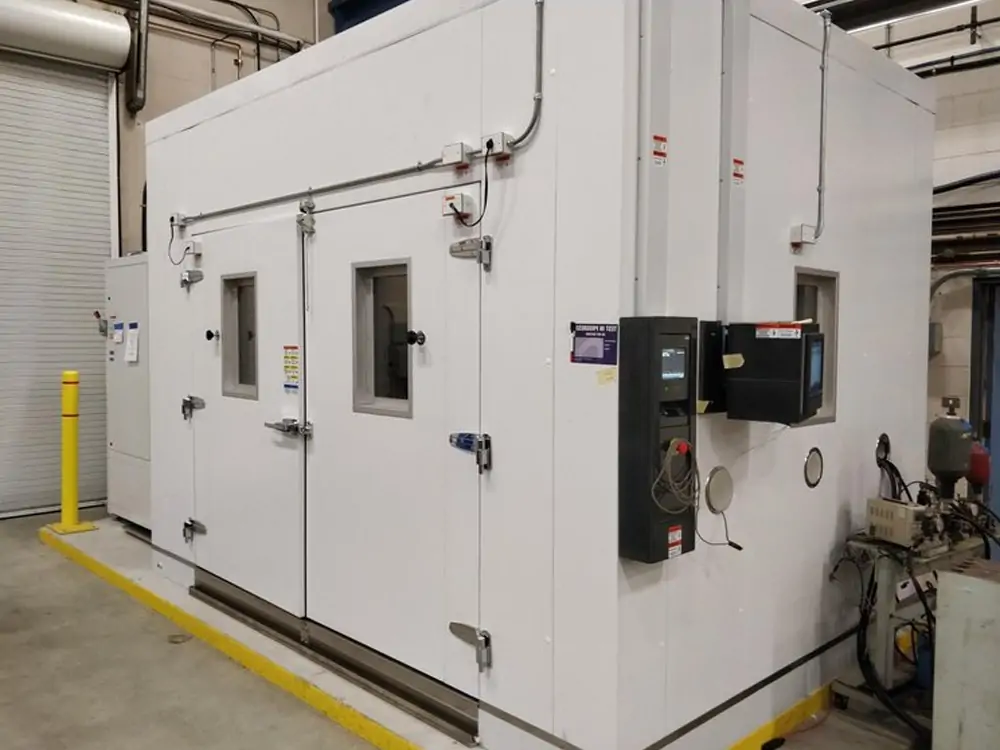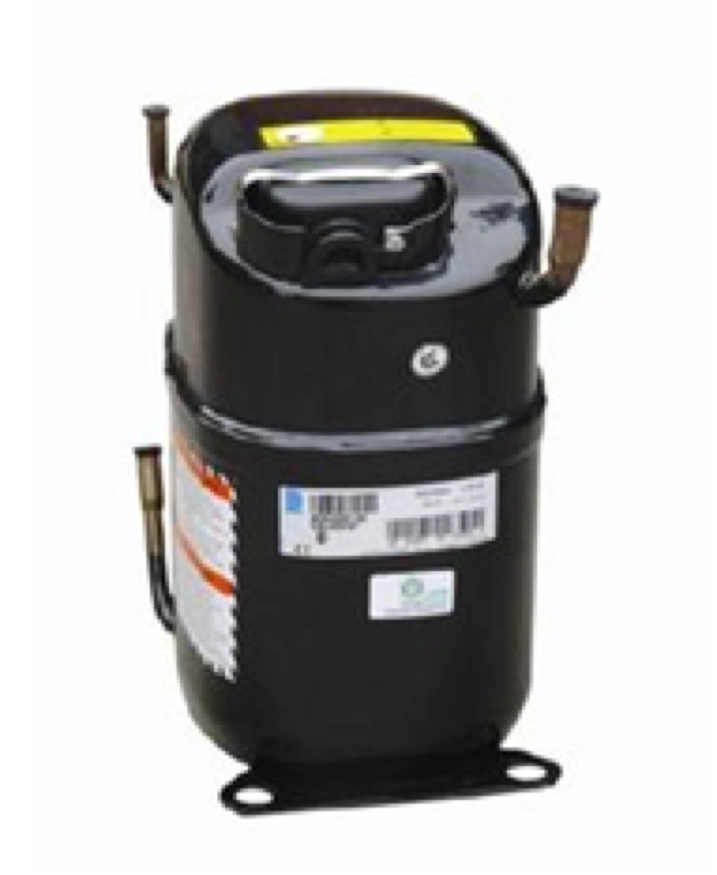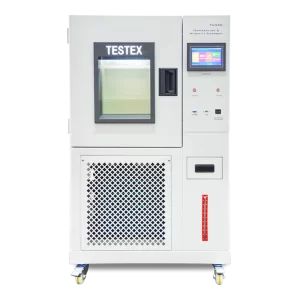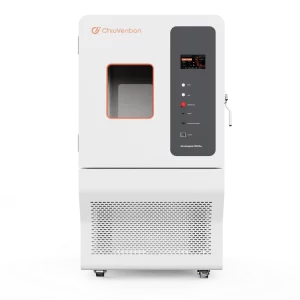Introduction
The climatic chamber, also known as a climate chamber, is a crucial tool for controlled environmental testing. These Climatic chambers serve a crucial purpose in various industries. These tools help researchers, engineers, and manufacturers simulate climate conditions. They use them to test how well products endure and perform.

Definition and Purpose of Climatic Chamber
The climatic chamber is a particular testing chamber. It makes precise conditions for testing, like temperature and humidity. We use these chambers to copy extreme weather, from hot to cold. We do this to test how products and materials behave and perform.
Overview of Article Content
In this article, we’ll explore why climate chambers matter for controlled testing. We’ll also see how they’re used across different industries. Furthermore, We’ll also discuss the differences between the environmental chamber and the climatic chamber. This article also clarifies the climatic chamber’s future innovations.
Importance of Controlled Environmental Testing
Controlled environmental testing is crucial in aerospace, automotive, electronics, and pharmaceuticals. It ensures product quality and reliability by simulating real-world conditions. For example, automotive firms use the climatic chamber to test extreme temperature performance. Moreover, pharmaceutical companies check drug stability in varying humidity levels.
Climatic Chamber Vs. Environmental Chamber

1. Purpose:
- The Climatic Chamber is primarily designed for testing and simulating specific temperature and humidity conditions. These abilities make them suitable for evaluating products’ performance under varying climates.
- The Environmental Chamber is more versatile. It encompasses a broader range of environmental factors beyond temperature and humidity. Such as vibration, altitude, and light.
2. Types:
The Climatic Chamber comes in variations like:
- Temperature Chamber
- Humidity Chamber
- Temperature-Humidity Chambers
The Environmental Chambers include a diverse range of types:
- Vibration Chamber
- Altitude Chamber
- Corrosion Chamber
- UV Chamber
- Thermal shock Chamber
- Salt spray Chamber
3. Cost:
- The Climatic Chamber is generally more affordable compared to some specialized environmental chambers. Because of its narrower focus.
- The Environmental Chamber can be more expensive. Particularly those equipped with advanced features for comprehensive testing.
Types of Climatic Chambers
Climatic chambers serve distinct purposes in testing and research. Let’s explore their key differences and the various types of these chambers available.
Temperature Chambers
Temperature chambers are designed to mimic extreme temperature conditions. They can create extreme cold or heat conditions for testing purposes. Temperature chambers are used to estimate the influence of temperature deviations on products.
Humidity Chambers
Humidity chambers focus on replicating different humidity levels. They help evaluate how products react to moisture in the air. They’re crucial for assessing durability in electronics, textiles, and pharmaceuticals in humid conditions.
Combined Temperature and Humidity Chambers:
Combined chambers provide accompanying control of temperature and humidity. They are perfect for testing products in different climates. They ensure product durability in varying weather, from auto parts to aerospace materials.
Key Components of Climatic Chamber
A Climatic chamber comprises key components that work seamlessly to create and maintain specific climatic conditions. Let’s explore these crucial elements:

Taikang Compressor (Top Grade)
The compressor is the heart of the climate chamber
Temperature Control Systems
- Heating Elements such as electric heaters or heating coils, raise the temperature inside the chamber.
- Cooling mechanisms, like compressors and refrigerants, lower the temperature when needed. ( ChiuVention using the best compressor to make sure the climate chamber can maintain the best performance. )
Humidity Control Systems
- Humidifiers add moisture to the chamber, increasing humidity levels as required.
- Dehumidifiers remove excess moisture from the chamber to maintain desired humidity levels.
Control and Monitoring Systems
- Sensors detect temperature and humidity, ensuring accurate monitoring.
- Controllers manage the chamber’s temperature and humidity, making real-time adjustments.
Airflow and Ventilation
- Airflow and ventilation systems regulate air circulation within the chamber, ensuring uniform conditions.
- These systems maintain consistent temperature and humidity throughout the chamber. Also, these systems ensure accuracy in test results.
Applications of the Climatic Chamber
Climatic chambers have applications in many industries for a wide range of purposes. Here, we explore the diverse uses of these chambers in different sectors:
Automotive Industry
- These chambers precisely evaluate how vehicles respond to extreme temperature variations.
- Automotive parts endure rigorous tests to check how well they withstand different environmental conditions.
Aerospace Industry
- These chambers replicate space and high-altitude conditions to test and validate spacecraft design.
- Key components of spacecraft, like sensors and materials, undergo thorough examination for reliability.
Electronics Industry
- Electronic components face temperature fluctuations; this chamber helps identify potential failures.
- Electronics exposed to varying conditions are tested to guarantee long-lasting and dependable devices.
Pharmaceuticals and Biotechnology
- These chambers play a vital role in deciding how long pharmaceutical products last and how stable they remain.
- These chambers create ideal environments for cultivating microorganisms used in biotechnology and research.
Environmental Studies
- These chambers help us study climate change’s effects on ecosystems and species.
- Scientists recreate ecosystems in these chambers and study their reactions to changing conditions.
Benefits and Advantages of the Climatic Chamber
The Climatic Chamber offers numerous benefits and advantages across various industries. Let’s explore four key aspects where these chambers prove to be invaluable:
Accelerated Testing
The Climatic Chamber enables accelerated testing of products, helping manufacturers identify potential issues quickly. These chambers simulate extreme environmental conditions, such as extreme temperatures and humidity. Additionally, they help to assess a product’s durability and performance over time. This advantage accelerates product development and guarantees reliability.
Cost Reduction:
One of the most meaningful advantages of using this chamber is cost reduction. Climatic chamber offers cost savings by catching issues early. Hence, this prevents expensive rework, warranties, and recalls, boosting the brand’s reputation for quality.
Quality Assurance:
Quality assurance is paramount in any industry, and the climatic chamber plays a vital role in ensuring product quality. Through rigorous testing, this chamber helps manufacturers maintain consistent quality standards. This advantage boosts customer happiness and keeps them coming back.
Environmental Impact Assessment:
Lastly, this chamber is an essential tool for estimating the environmental impact of products. It allows manufacturers to understand how their products perform under various conditions.
Challenges and Limitations of the Climatic Chamber
Climatic chambers are valuable tools for various industries, enabling precise environmental testing. Yet, they come with several challenges and limitations that must be dealt with.
Energy Consumption
One significant challenge is the high energy consumption of the climatic chamber. This chamber needs a lot of power to control temperature, humidity, and conditions. This raises both operational costs and environmental worries.
Maintenance Costs
These chambers demand regular maintenance to ensure accurate and reliable testing conditions. Maintenance costs can be significant, involving calibration, sensor replacements, and system checks. Proper upkeep is essential to prevent data inaccuracies and equipment failures.
Scale and Size Limitations
Another limitation is the restricted scale and size of these chambers. These chambers are small and unsuitable for big products or prototypes. This makes them less useful for industries handling oversized items. Scaling up chamber size can be expensive and may require extensive modifications.
Real-world Variability
These chambers create controlled settings, but they struggle to mimic real-world variation. Natural environments are dynamic with wind, sunlight, and atmospheric changes. This can impact test result accuracy.
Future Trends and Innovations in Climatic Chambers
These chambers are evolving to meet changing needs in testing and research. Here, we’ll discuss four trends shaping their future.
Energy-efficient Designs
Climatic chambers are becoming more energy-efficient, reducing operational costs and environmental impact. New designs use advanced insulation and efficient heating/cooling systems to save energy. These improvements ensure precise temperature and humidity control while being environmentally responsible.
Integration with AI and IoT
The integration of Artificial Intelligence (AI) and the Internet of Things (IoT) are revolutionizing these chambers. AI algorithms optimize chamber performance, making real-time adjustments for improved accuracy. IoT connectivity allows remote monitoring and control, enhancing convenience and efficiency.
Miniaturization and Portability
Miniaturization is a significant trend in these chambers. Smaller, portable models are gaining popularity for their versatility. Moreover, these compact chambers are ideal for on-site testing, reducing the need for large laboratory spaces. Researchers and industries can now conduct experiments wherever needed.
Environmental Sustainability
Environmental sustainability is at the forefront of climatic chamber innovations. Climate Chambers are being designed with eco-friendly refrigerants and materials. Efforts are being made to minimize waste and emissions during manufacturing and operation. The goal is to align climatic chamber technology with global sustainability initiatives.
For more environmental test chamber, Please visit: https://chiuventionclimatechamber.com
For more environmental test simulation programmes,environmental testing knowledge, instrument knowledge, and environmental testing laboratory knowledge, please contact us: [email protected]


